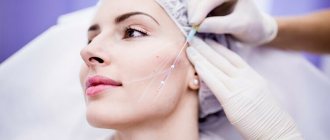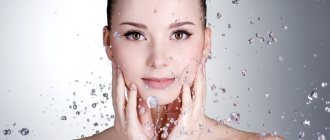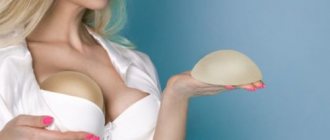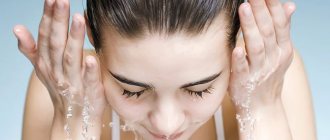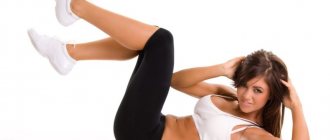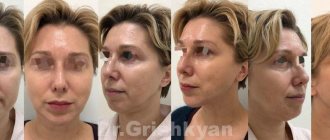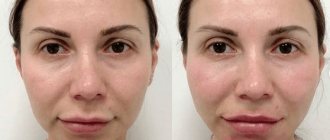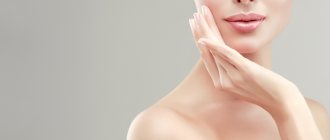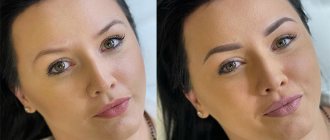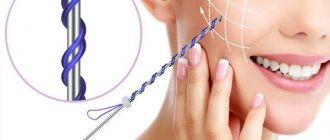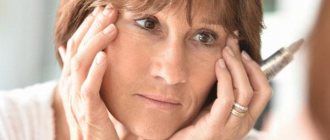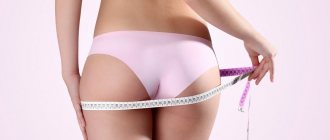Thread lifting quickly solves various aesthetic problems; Suitable for both women and men. Subcutaneous implantation of threads for a facelift is the optimal choice for patients under 50 years of age, when the first signs of age-related changes become noticeable: bags under the eyes, wrinkles on the forehead and near the eyes, sagging skin in the cheek area, pronounced nasolabial folds and in the mouth area, blurred facial contours . Thread face lifting is a smart choice if you don’t need a radical correction, are afraid of pain, and don’t have time for a long recovery. Compared to plastic surgery, the thread lifting procedure, that is, reinforcing the skin with threads, is low-traumatic and safe (the term “reinforcement” is borrowed from construction theory and means strengthening from the inside with a frame of fibers that are inserted under the skin along certain mesh lines).
A visible and natural result is ensured by the mechanical fixation of skin tissues with special, thinnest threads, and the long-term effect is ensured by their appearance and composition.
The risk of complications after a facelift with threads is low, the manipulation itself takes no more than an hour. The first days are characterized by swelling; complete tissue restoration takes about a month and a half; no scars remain. The result with a cumulative effect over several months lasts up to 5 years
What is used for the lifting procedure
Special guide needles and sterile biocompatible threads are used to gently tighten the skin of the face and other areas, meaning that when inserted they do not cause rejection, allergic or immune reactions. Threads differ in type, composition, texture, method of placement and fixation in tissues. When choosing a base material for lifting, it is best to trust a doctor who will take into account your wishes and body characteristics.
Next, we will help you navigate the variety and effectiveness of threads that are used for anti-aging procedures.
Content:
- The essence of the method, features and advantages
- Advantages of the technique
- Types of threads for facelift
- Absorbable threads
- Non-absorbable threads
- Smooth threads
- Notched threads
- Popular types of threads used in cosmetology
- Mesothreads
- Aptos
- Gold and platinum
- Silhouette Soft Elevator
- Progress of the procedure
This is a low-invasive technique that provides quick and effective correction. It makes it possible to select the lifting technique individually to achieve the best result in each case.
A facelift by introducing special threads under the skin is today one of the alternatives to complex surgery. It allows you to maintain youth and correct many imperfections.
The essence of the method, features and advantages
The lifting technique involves implanting medical threads under the patient’s skin, which are subsequently overgrown with new fibers of their own elastin and collagen. Over time, the threads dissolve, breaking down into water and carbon dioxide. A natural frame remains in the tissues, keeping them in a taut state. Another type of thread is non-absorbable. They consist of biologically compatible materials and remain in the tissues, serving as a dense frame that smoothes and tightens the skin.
The procedure allows you to cope with the changes that are inevitable after 30-50 years. These may include folds, wrinkles, sagging and ptosis of the skin.
Advantages of the technique
- With the help of thread lifting, only the skin is smoothed and imperfections are eliminated. The effect of changing facial features is excluded.
- There are no signs of intervention. The threads are also not felt at all even when touched and are not visible.
- Possibility of tightening deep wrinkles in the eye area, eliminating drooping eyelids.
- Fast recovery – approximately 5 days.
- There is a lower risk of complications and side effects, while the result is comparable to a circular lift.
- The ability to select the best threads and vectors for their introduction in each specific case, that is, a completely individual approach.
Indications:
- deep nasolabial groove;
- age-related tissue ptosis;
- sagging cheeks;
- shaved;
- “puppet” wrinkles;
- facial asymmetry;
- drooping of the eyebrows along the outer edge;
- drooping cheekbones;
- chin laxity.
Contraindications:
- pregnancy and lactation;
- oncopathology;
- autoimmune diseases;
- diabetes;
- poor blood clotting;
- acute forms of chronic diseases;
- general infectious diseases;
- intolerance to implanted materials;
- severe excess skin tissue;
- thrombosis and some other blood pathologies.
What is included in the lower area of the face?
Experts refer to the lower part of the face as the mental and submental zones, that is, the neck, submandibular region, chin, cheek-zygomatic region and jowl area.
Depending on the correction area, skin thickness and the purpose of the work, threads are selected, their configuration, length and installation method are determined, of which there are more than a dozen.
As part of the correction of this area, a chin lift with threads is performed, as well as a neck lift. This allows the skin to return to a more youthful and toned appearance.
Types of threads for facelift
There are two main classifications of threads: according to the materials from which they are composed, and according to their texture.
Based on materials, threads are divided into biodegradable (which dissolve over time) and non-absorbable.
Absorbable threads
Such threads are implanted into the surface layers of tissue. At the sites of their introduction, the synthesis of one’s own elastin and collagen is activated, due to which a natural frame of connective tissue is formed around the threads. After administration, the material is gradually eliminated from the body over several months (it is reabsorbed). However, the rejuvenating effect lasts for another 2-3 years, because the elastin-collagen framework remains in place of the threads.
The injection procedure is almost painless and is performed with the thinnest guide needles. It can be performed with or without local anesthesia.
Such threads are effective for the prevention of age-related imperfections or for the correction of changes that have just begun. Recommended for people under 40 years of age.
A cosmetologist can choose one of two types of absorbable threads:
- from polydioxanone;
- based on polylactic acid.
Polydioxanone threads are implanted into the hypodermis, that is, into the skin itself. They are additionally saturated with lactic acid to activate collagen production. During bioreactions after the installation of threads, skin rejuvenation occurs, as it has a positive effect on its structure.
Polylactic acid is a well-known suture material that dissolves over time and is actively used in surgery. Threads based on it are implanted under the skin, and after 7-9 months they are completely removed naturally. At the same time, collagen and hyaluronic acid are actively produced in the tissues that surround them. As a result, the skin is smoothed, moisturized, tightened, and acquires a healthy color.
Non-absorbable threads
Such material is not removed from the body - the threads are firmly fixed in the soft tissues at the level of the aponeurosis. They may consist of the following biocompatible (non-rejectable) materials:
- polypropylene (medical variety);
- platinum;
- gold.
Polypropylene is characterized by increased wear resistance. Threads made from it have notches on the surface, which provide strong fixation at the level of subcutaneous fat. Can be supplied with biodegradable cones.
Gold and platinum are combined elements in which a polyglycol absorbable conductor is present: it gradually biodegrades, and the metal thread remains in the tissues. Injected into the deep and middle layers of soft tissues, they allow you to eliminate pronounced ptosis and sagging. The tightening effect lasts for 4-6 years.
Now let's look at the features of the thread structure. Based on this feature, they are divided into two large groups: smooth and notched.
Smooth threads
They allow you to tighten your cheekbones, chin, cheeks, and create an aesthetic eyebrow contour. When inserted, small incisions (up to 5 mm long) are required. They are recommended for women aged 45-50 years.
The surface of such threads is even and smooth; they are implanted into the deep layers of the skin in the form of loops and attached to the bone tissue.
Notched threads
They have “hooks” on the surface, which improves the quality of their fixation in tissues. They are inserted to a depth of 4-5 mm, no incisions are required for this - only punctures.
There are also threads:
- "Springs." They have an improved ability to keep the skin taut.
- Spiral. They allow you to tighten the oval of the face and achieve a good modeling effect due to the ability to take the same shape after stretching.
- Conical. They have biodegradable “nodules” in the shape of cones on the surface. The fixing elements dissolve a year after implantation.
Rejuvenation schemes for ladies of elegant age
Here are the schemes that experts recommend:
Upper third of the face: botulinum toxin in wrinkles of the forehead, between the eyebrows, outer corners of the eyes and for the correction of ptosis (drooping) of the eyebrows. After 2 weeks, when the botulinum toxin “rises” - fillers into deep wrinkles, retraction in the temple area and for visual eyebrow lifting. After another 10 days - eyebrow thread lifting.
Middle third of the face: thread lift to correct ptosis. A month later - injection contour plasty: restoration of volume in place of lost adipose tissue, correction of the lacrimal, palpebromalar, midzygomatic groove, nasolabial fold. Botulinum toxin is rarely used in this area: to correct the so-called gingival smile, which exposes the gums.
Lower third of the face: botulinum toxin to relax the muscle that depresses the corners of the mouth and the subcutaneous muscle of the neck (allows you to slightly correct the lower jaw line). “Purse-string” wrinkles around the mouth are also corrected. After 2 weeks – thread lifting to eliminate ptosis. A month later - fillers in the oromental folds, purse-string wrinkles, ring wrinkles on the neck.
But, of course, in each individual case, the doctor chooses specific methods and the sequence of their use, taking into account the characteristics of the patient’s face. However, an integrated approach is always necessary, otherwise the result may be disappointing.
Thread lifting can be combined not only with the described techniques. After it, it is allowed to use laser (Fraxel), radio wave lifting (Thermage), biorevitalization, mesotherapy and other injection methods that speed up recovery.
Popular types of threads used in cosmetology
Mesothreads
They consist of hypoallergenic absorbable suture and have a braided structure. The main composition is zinc, hyaluronic acid. They gradually dissolve after injection, and in their place remains a natural collagen frame that tightens the skin. Allows you to eliminate minor age-related defects. Thanks to the content of hyaluronic acid, they increase skin elasticity and moisturize.
Mesothreads are used to tighten the face and neck; they are also used to eliminate sagging on the chest, abdomen, buttocks, and to smooth out the skin after liposuction.
Aptos
They have “teeth” on the surface, thanks to which they are firmly fixed in the tissues. They are inserted to a depth of about 3-5 mm, no incisions are required - only micropunctures. They are either absorbable or non-absorbable. In the first case, the effect lasts for about two years, in the second – up to four.
It is important to trust the insertion of such cosmetic threads only to a professional, since the consequences of an unsuccessful facelift will persist for quite a long time if the cosmetologist makes a mistake.
The advantages of Aptos threads include: the absence of incisions, the possibility of insertion without anesthesia (due to the fact that they are very thin), and an affordable price.
Gold and platinum
They have a metal part and a polyglycol element, which gradually dissolves. Allows you to eliminate serious sagging skin and deep wrinkles.
They are implanted deeply, due to which all layers of the skin are tightened. The effect lasts for 4-6 years or more with the right lifestyle.
Silhouette Soft and Silhouette Lift
They belong to the combined type, have cones and “nodules” on the surface that improve fixation in the tissues. The base consists of polypropylene, the “hook” is made of glycolide. Recommended for people under 50 years of age, the recovery period is about two weeks. Well suited for correcting facial contours.
Fastening methods
Modern cosmetology uses 2 techniques for securing lifting threads. Each of them has its own characteristics and benefits. Let's look at the main differences.
Fixed
The essence of this method is that the cosmetic material is attached to the temporal and ear areas. This helps eliminate flabbiness and sagging of the epidermis, and also simultaneously corrects the oval of the face. This option is more suitable for people over 40 who need intensive rejuvenation.
Autonomous
Autonomous technique is carried out without fixing the inserted fibers. It is aimed exclusively at eliminating the first signs of loss of elasticity and skin aging. Suitable mainly for patients in the age range of 30–40 years.
Important!
After a thread facelift, you should refrain from sudden facial and chewing movements for 2 weeks, since during this period a collagen framework is formed around the implants. Massage procedures, peeling, hardware cosmetology on the neck and face are permissible only after 2 months.
Procedure technology
Patients are often interested in how many threads are needed for a facelift procedure. On average, about 30, although it all depends on the volume of intervention, the type of threads and the chosen correction tactics.
During preparation (after consultation with a doctor), you should avoid medications that affect blood clotting. The cosmetologist must collect anamnesis to exclude contraindications.
In a few days you need to give up alcohol, smoking, and increased physical activity. Women are advised to postpone the procedure until after menstruation.
Progress of the procedure
The tightening time is up to 40 minutes.
- The patient sits in a special cosmetology chair. If the procedure takes place in an operating room, then it lies on the table.
- Examination of the face, cleansing, marking.
- The doctor takes a photo of the patient to compare the result before and after in standard projections.
- Providing topical anesthesia (sometimes general anesthesia may be used).
- Implantation of threads, their tightening to simulate the desired result, trimming the ends of the threads.
- Treating punctures with an antiseptic and applying a sterile bandage.
Contraindications to thread implantation
Contraindications to thread lifting are also quite traditional, as for any other interventions. This is any acute infection, including ARVI, fever; skin diseases with manifestations in the facial area; autoimmune diseases such as systemic lupus erythematosus or rheumatoid arthritis. Thread lifting should not be done if there is a tendency to form keloid scars (including when close blood relatives have such scars); blood clotting disorders; for oncological pathology and diabetes mellitus. Another relatively rare contraindication is non-biodegradable implants present in the correction area.
Implantation of threads can cause not many complications. Most often these are hematomas - “bruises” and swelling: when inserting even the thinnest needles, a vessel can be injured, and swelling occurs during aseptic (microbial-free) inflammation caused by a foreign body. Actually, the rejuvenation of facial tissues when using threads is based on inflammation and the activation of metabolism caused by it. Therefore, swelling in the first three days and its persistence for up to 2 weeks is a normal development of events and should not cause concern. To make swelling and bruising resolve faster, you can use Heparin ointment, Troxevasin and Traumeel gels, and physiotherapy (microcurrents).
If you neglect the doctor's recommendations and do not restrain your facial expressions, the end of one or more threads may come out from under the skin. There is no need to panic - you need to contact the specialist who performed the manipulation, who will remove the thread that came out and install a new one.
If you do not thoroughly wash off your makeup before the procedure (or do not treat your face well with an antiseptic), or neglect the temporary ban on decorative cosmetics, an infection may occur and inflammation may develop. In this case, you need to urgently consult a doctor so that he can prescribe antibiotics.
Perhaps one of the most unpleasant complications is the formation of fibrous cords along the threads. In principle, new collagen formation is exactly the effect for which thread lifting is done. But if the body is prone to excessive scarring, dense fibrous cords may form instead of a thin supporting frame.
Implantation of threads is perfectly combined with other methods of correcting age-related changes in the face. Biorevitalization and mesotherapy are not only allowed, but also recommended - they will allow you to recover faster after manipulation. In the same way, after thread lifting, you can do contour plastic surgery, use fractional laser, RF lifting devices and use other procedures that provide facial rejuvenation without surgery - this will extend the effect of implantation to 3-4 years.
Possible complications
The following complications are not normal and require urgent consultation with a doctor:
- allergic reaction;
- impaired facial expressions;
- infection;
- displacement of threads;
- violation of the oval contour of the face;
- dents at puncture sites;
- threads showing through the skin.
Important! This procedure should be carried out by an experienced cosmetologist, only in this case there will be no consequences.
The specialists at Dr. Gruzdev’s clinic are qualified cosmetologists who are fluent in the technique. Thanks to this, our clients are consistently satisfied with the results.
